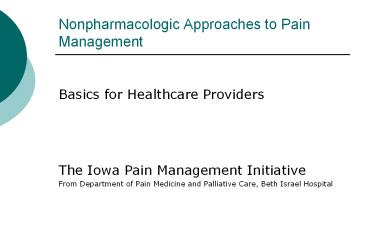Nonpharmacologic Approaches to Pain Management PowerPoint PPT Presentation
Title: Nonpharmacologic Approaches to Pain Management
1
Nonpharmacologic Approaches to Pain Management
- Basics for Healthcare Providers
- The Iowa Pain Management Initiative
- From Department of Pain Medicine and Palliative
Care, Beth Israel Hospital
2
Psychologic Treatmentsfor Chronic Pain
- Behavioral treatment
- Biofeedback
- Cognitive-behavioral treatment
3
Behavioral (Operant) Treatment Model
- Operant focus on behavior
- Use of medication
- Pattern of daily activities (eg, rest)
4
Behavioral Treatment Intervention
- Change the consequences of (pain) behavior
- Medications administered on a schedule
ratherthan PRN - Social responses, particularly spouses and
families, shift from pain-related to activity-
and wellness-related communication training
often integrated - Pacing of daily activities diminishes both
aversive consequences of being active and
positive consequences of rest record keeping,
daily logs often critical
5
Behavioral Treatment Outcomes
- Reduce pain
- Reduce anxiety
- Improve coping
- Increase activity level
- Reduce pain behavior
6
Biofeedback Model
- Psychophysiologic
- Physiologic responses that are not typically
under voluntary control or have become
dysregulated - Stress responses to pain and emotional
challenges of living with chronic pain
7
Biofeedback Intervention
- Learning to influence physiologic parameter
- Electromyography
- Galvanometry (electrodermal)
- Temperature
- Shaping of behavior
- Typically includes training in relaxation
techniques
8
Biofeedback Outcomes
- NIH Technology Assessment Panel
- Evidence is moderate for the effectiveness of
biofeedback in relieving many types of pain - For example
- Reduction in tension and migraine headaches
- Reduction in episodes of Raynauds
9
Cognitive-Behavioral Treatment Model
- Affect and behavior are largely determined by
cognitive processes - Behavior results from a complex interaction
between cognitive structures (eg, beliefs),
cognitive processes (eg, automatic thoughts),
overt responses, and the intrapersonal and
interpersonal consequences of these multiple
components
10
Cognitive-Behavioral Treatment Intervention
- Integrates behavioral and biofeedback
interventions - Adds focus on cognitive structures and cognitive
processes
11
Cognitive-Behavioral TreatmentIntervention
- Sessions focus on identifying and challenging
maladaptive cognitive structures and processes - Homework focuses on personal experiments
designed to test the validityof cognitive
structures and processes
12
Cognitive-Behavioral Treatment Intervention
- Emphasis on self-management
- Share 4 common components
- Education
- Skills acquisition
- Cognitive and behavioral rehearsal
- Generalization and maintenance
13
Cognitive-Behavioral Treatment Outcomes
- NIH Technology Assessment Panel
- The evidence is strong for the effectiveness of
(relaxation) in reducing chronic pain in a
variety of medical conditions - The evidence is moderate for the usefulness of
cognitive-behavioral treatment in chronic pain
14
Rehabilitative Approaches
- Physical therapy and exercise
- Work hardening and functional restoration
15
Physical Therapy and Exercise
- Patient educationback school
- Best effects when integrated into a comprehensive
rehabilitation program - Electrotherapeutic and thermal interventions
- Exercise
- Recommended for chronic low back pain,
osteoarthritis, fibromyalgia
16
Work Hardening and Functional Restoration
- Aggressive physical therapy
- Work conditioning
- Psychosocial support
17
Complementary/Alternative Approaches
- Spinal manipulation
- Acupuncture
- Massage
- Heat or cold therapy
- Hatha yoga
- Healing Touch
- Tai chi
- Meditation
18
Complementary/Alternative Approaches
- Spinal manipulation
- Study quality is generally poor and findings
inconsistent across studies - Overall, studies suggest efficacy forlow back
pain - Subgroups of individuals may benefit more
19
Complementary/Alternative Approaches
- Acupuncture
- Reviews of the available studies support the
efficacy of acupuncture for musculoskeletal pain,
recurrent headache, osteoarthritis knee pain, and
possibly fibromyalgia
20
Complementary/Alternative Approaches
- Massage
- Manipulates muscles, tendons, ligaments
by applying pressure to the body
21
Complementary/Alternative Approaches
- Heat or cold therapy
- Applies heat or cold directly to an area
- Increases or constricts blood flow, depending
- On type of pain being addressed
22
Complementary/Alternative Approaches
- Hatha Yoga
- Focuses on physical poses and controlled
- breathing
- Reduces stress
- Enhances peacefulness in body and mind
23
Complementary/Alternative Approaches
- Healing Touch
- Reorients energy in the body to allow and support
healing
24
Complementary/Alternative Approaches
- Tai Chi
- Moving in a series of slow, relaxed continuous
movements - Focus on breathing and meditation
25
Complementary/Alternative Approaches
- Meditation
- Emptying the mind of thought
- Focus on breathing, a sound, or an object

